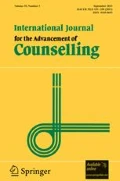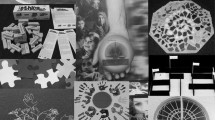Abstract
Practicum experience in counseling and therapy training can be an anxiety-inducing time as students begin to apply their acquired theoretical knowledge. On-site supervisors closely monitor students’ development by making use of example-based involvements to provide valuable insights and learning opportunities. This paper examines the findings from a pragmatic inquiry, where seven on-site supervisors were interviewed about their experiences supervising counseling and art therapy practicum students. By using qualitative analysis, the authors were able to elicit themes that demonstrated important qualities for all counseling and therapy students during this learning stage, as well as for art therapy students in particular.
Similar content being viewed by others
References
American Art Therapy Association. (2013). What is art therapy. Retrieved from http://www.arttherapy.org/upload/whatisarttherapy.pdf.
Braun, V., & Clarke, V. (2006). Using thematic analysis in psychology. Qualitative Research in Psychology, 3(2), 77–101. doi:10.1191/1478088706qp063oa.
Braun, V., Clarke, V., & Terry, G. (2014). Thematic analysis. In P. Rohleder & A. Lyons (Eds.), Qualitative research in clinical and Health Psychology (pp. 95–113). Basingstoke, UK: Palgrave MacMillan.
Duncan, B. (2010). On becoming a better therapist. American Psychological Society: Washington D.C.
Ducheny, K., Alletzhauser, H. L., Crandell, D., & Schneider, T. R. (1997). Graduate student professional development. Professional Psychology: Research and Practice, 28(1), 87–91. Retrieved from http://dx.doi.org/10.1037/0735-7028.28.1.87.
Elliot, R., Fischer, C., & Rennie, D. (1999). Evolving guidelines for publication of qualitative research studies in psychology and related fields. British Journal of Clinical Psychology, 38(3), 215–229. doi:10.1348/014466599162782.
Elkis-Abuhoff, D., Gaydos, M., Rose, S., & Goldblatt, R. (2010). The impact of education and exposure on art therapist identity and perception. Art Therapy: Journal of the American Art Therapy Association, 27(3), 119–126. doi:10.1080/07421656.2010.10129666.
Feen-Calligan, H. (2005). Constructing professional identity in art therapy through service-learning and practica. Art Therapy: Journal of the American Art Therapy Association, 22(3), 122–131. doi:10.1080/07421656.2005.10129490.
Feen-Calligan, H. (2012). Professional identity perceptions of dual-prepared art therapy graduates. Art Therapy: Journal of the American Art Therapy Association, 29(4), 150–157. doi:10.1080/07421656.2012.730027.
Flückiger, C., Wüsten, G., Zinbarg, R., & Wampold, B. (2010). Resource activation: Using clients’ own strengths in psychotherapy and counseling. Cambridge, MA: Hogrefe Publishing.
Furr, S. R., & Carroll, J. J. (2003). Critical incidents in student counselor development. Journal of Counseling and Development, 81(3), 483–489.
Gussak, D. E., & Orr, P. (2005). Ethical responsibilities: Preparing students for the real art therapy world. Art Therapy: Journal of the American Art Therapy Association, 22(2), 101–104. doi:10.1080/07421656.2005.10129445.
Hazler, R., & Kottler, J. (2005). The emerging professional counselor: Student dreams to professional realities (2nd ed.). Alexandria, VA: American Counseling Association.
Hill, C. E., Sullivan, C., Knox, S., & Schlosser, L. Z. (2007). Becoming psychotherapists: experiences of novice trainees in a beginning graduate class. Psychotherapy: Theory, Research, Practice, Training, 44(4), 434–449. doi:10.1037/0033-3204.44.4.434.
Hersoug, A. G., Høglend, P., Havik, O., von der Lippe, A., & Monsen, J. (2009). Therapist characteristics influencing the quality of alliance in long-term psychotherapy. Clinical Psychology & Psychotherapy, 16(2), 100–110. doi:10.1002/cpp.605.
Kapitan, L. (2012). Educating the future practitioner of art therapy. Art Therapy: Journal of the American Art Therapy Association, 29(4), 148–149. doi:10.1080/07421656.2012.735930.
Kegan, R. (1994). In over our heads: The mental demands of modern life. Cambridge, MA: Harvard University Press.
Koltz, R., & Champe, J. (2010). A phenomenological case study: The transition of mental health counseling interns from students to professionals. Ideas and Research You Can Use: VISTAS 2010. 1–11. Retrieved from http://counselingoutfitters.com/vistas/vistas10/Article_31.pdf.
Lincoln, Y., & Guba, E. (1985). Naturalistic inquiry. Newbury Park, CA: Sage.
McNiff, S. (1986). Educating the creative arts therapist: A profile of the profession. Springfield, IL: Charles C. Thomas.
Moon, B. (2003). Essentials of art therapy education and practice (2nd). Springfield, IL: Charles C Thomas.
Oppegard, K., Omaha, N., Elkins, D., Abbenante, J., & Bangley, B. (2005). Choosing art therapy as a career. Art Therapy: Journal of the American Art Therapy Association, 22(2), 92–100. doi:10.1080/07421656.2005.10129444.
Orkibi, H. (2010). Creative art therapies students’ professional identity and career commitment: A brief pilot study. The Arts in Psychotherapy, 37(3), 228–232. doi:10.1016/j.aip.2010.04.008.
Orkibi, H. (2011). Creative arts therapies students’ professional development: Mixed methods longitudinal research (Unpublished doctoral dissertation). Massachusetts: Lesley University.
Orkibi, H. (2012a). A field training model for creative arts therapies: Report from a 3-year program evaluation. Art Therapy: Journal of the American Art Therapy Association, 29(4), 174–179. doi:10.1080/07421656.2012.730930.
Orkibi, H. (2012b). Arts therapies students’ scores in profession related variables: Quantitative results of a longitudinal study. Body, Movement and Dance in Psychotherapy: An International Journal for Theory, Research and Practice, 7(2), 129–144. doi:10.1080/17432979.2012.659678.
Orkibi, H. (2014). The applicability of a seminal professional development theory to creative arts therapies students. Clinical Psychology & Psychotherapy, 21(6), 508–518. doi:10.1002/cpp.1851.
Orlinsky, D. E., Rønnestad, M. H., & Willutzki, U. (2004). Fifty years of psychotherapy process outcome research: Continuity and change. In M. J. Lambert (Ed.), Bergin and Garfield’s handbook of psychotherapy and behavior change (5th ed., pp. 307–389). New York: Wiley.
Orr, P., & Gussak, D. (2005). Getting tangled in the web: A systems theory approach to supervision. Art Therapy: Journal of the American Art Therapy Association, 22(3), 161–163. doi:10.1080/07421656.2005.10129494.
Patton, M. Q. (2015). Qualitative research and evaluation methods (4th ed.). Los Angeles, LA: Sage.
Potash, J. S., Bardot, H., & Ho, R. (2012). Conceptualizing international art therapy education standards. The Arts in Psychotherapy, 39(2), 143–150. doi:10.1016/j.aip.2012.03.003.
Robbins, A., & Seaver, L. (1994). Becoming an art therapist. In A. Robbins (Ed.), A multi-modal approach to creative arts therapy (pp. 18–30). London, UK: Jessica Kingsley.
Rønnestad, M., & Skovholt, T. (2003). The journey of the counselor and therapist: research findings and perspectives on professional development. Journal of Career Development, 30(1), 5–44. doi:10.1023/A:1025173508081.
Rorty, R. (1999). Philosophy and social hope. New York, NY: Penguin.
Rosiek, J. (2013). Pragmatism and post-qualitative futures. International Journal of Qualitative Studies in Education, 26(6), 692–705. doi:10.1080/09518398.2013.788758.
Schaverien, J. (2000). The triangular relationship and the aesthetic countertransference in analytical art psychotherapy. In A. Gilroy & G. McNeilly (Eds.), The changing shape of art therapy: New developments in theory and practice (pp. 55–84). London, UK: Jessica Kingsley.
Skovholt, T., & Jennings, L. (2004). Master therapist: Exploring expertise in therapy and counseling. Needham Heights, MA: Allyn & Bacon.
Skovholt, T., & Rønnestad, M. (2003). Struggles of the novice counselor and therapist. Journal of Career Development, 30(1), 45–58. doi:10.1023/A:1025125624919.
Stoltenberg, C. D., McNeill, B. W., & Delworth, U. (1998). IDM: The integrated developmental model of supervision. San Francisco: Jossey-Bass.
Strübing, J. (2007). Research as pragmatic problem-solving: the Pragmatist Roots of Empirically-grounded Theorizing. In A. Bryant & K. Charmaz (Eds.), The Sage handbook of grounded theory (pp. 580–602). London, UK: Sage.
Wampold, B. E. (2001). The great psychotherapy debate: Models, methods, and findings. Mahwah, NJ: Erlbaum.
Winnicott, D. W. (1964). The child, the family, and the outside world (2nd ed.). Harmondsworth, UK: Penguin Books.
Author information
Authors and Affiliations
Corresponding author
Rights and permissions
About this article
Cite this article
Van Lith, T., Voronin, L. Practicum Learnings for Counseling and Art Therapy Students: the Shared and the Particular. Int J Adv Counselling 38, 177–193 (2016). https://doi.org/10.1007/s10447-016-9263-x
Published:
Issue Date:
DOI: https://doi.org/10.1007/s10447-016-9263-x




